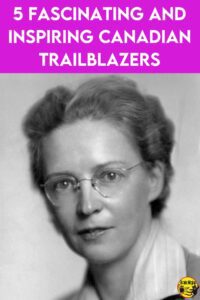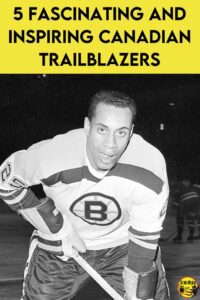
We teamed up with several Canadian teacher-authors to collaborate on different historical (and modern) Canadian trailblazers that you should be teaching your students about.
A trailblazer is the first to do something or to lead the way for others. This term is often used to describe someone who pioneers a new idea, creates a new path, or achieves something that has never been done before. Trailblazers are often seen as innovators or leaders who inspire others to follow in their footsteps. They create positive change in society. They may face challenges and obstacles along the way, but they persist in pursuing their goals and paving the way for others to follow.
How well do you know these Canadian trailblazers?
Mary Two-Axe Earley

Mary Two-Axe Earley fought for the rights of Indigenous women. She was born in the Kahnawake Mohawk Territory in Quebec in 1911. Caucasian women in Canada earned equal rights during the 1920s. When Mary was growing up, Indigenous women living in Canada did not have the same rights as other women. For example, if an Indigenous woman married a non-Indigenous man, she would lose her status and her children would not be considered Indigenous. If an Indigenous man married a non-Indigenous woman, he got to keep his status. Mary wanted to change this unfair law.
In the 1960s, Mary Two-Axe Earley started a campaign to change the law. She travelled across Canada to meet with Indigenous women and hear their stories. She talked to politicians and the media to raise awareness about the issue. Finally, in 1985, the Canadian government changed the law and Indigenous women could no longer lose their status if they married a non-Indigenous man. This was a huge victory for Mary and for Indigenous women across Canada.
Today, Indigenous women in Canada have more rights and opportunities thanks to Mary’s tireless efforts. There is much more work to be done, but she is a true inspiration to all of us and a reminder that one person can make a big difference. Your students can continue learning about Mary through this weekly reader written by Brain Ninjas on TpT ($USD) or their BN Shop ($CAN). It contains a short reading passage and several comprehension activities to use during your language arts class. It’s a great way to connect language arts and social studies.
The article about Mary-Two Axe Earley is part of a set of Canadian trailblazers that also includes:
- Willie O’Ree on TpT ($USD) or BN Shop ($CAN)
- Elsie MacGill on TpT ($USD) or BN Shop ($CAN)
- Stanley G. Grizzle on TpT ($USD) or BN Shop ($CAN)
Viola Desmond

Kristy from 2 Peas and a Dog wants Canadian students to learn about Viola Desmond who stood up to racism – and ended up in jail for it.
While travelling to a business meeting in 1946, Desmond’s car broke down in New Glasgow, Nova Scotia. She ended up having to book a hotel room and decided to see a movie. Desmond, a successful business owner with a beauty school and line of products, tried to purchase a ticket to main floor seating at the Roseland Theatre, but they would only sell her a ticket for the balcony. It was implicitly understood in the community that the balcony was for non-white patrons – although it was never flat-out said. Legally, the area was ambiguous as well – no court had ruled about whether it was legal to deny services based on race in theatres, hotels and restaurants.
At the theatre, Desmond took a seat on the main floor. At one point, she had offered to pay the difference in price between that and her balcony ticket.
Eventually, police were called and she was dragged out (and injured), taken to jail, and ended up having a trial with no lawyer where she was found guilty of not paying an amusement tax (the one-cent difference in main floor/balcony seating). The judge fined her $26 and it wasn’t until 2010 that Desmond was given a pardon.
Her Legacy
Decades after her death (in 1965), recognition of Desmond and her stand against racial segregation grew. In 2016, it was announced she would be the first woman to be on the face of a Canadian banknote. She has been inducted into Canada’s Walk of Fame and named a National Historic Person by the government. In 2021, the Nova Scotia government repaid Desmond’s fine – adjusted to $1,000 – after receiving a letter from a high school student who learned about Desmond for school. The money was given to her sister, who planned to use it for a scholarship. It wasn’t until 1954 that segregation was legally ended in Nova Scotia.
A great way to get students to use their knowledge about important people is to have them complete a fun Biography Assignment where students create a life map outlining the important events in their important person’s life.
Elsie MacGill

When it comes to the study of influential Canadians, Katie from Mochas and Markbooks thinks all students should learn about the lasting impact of Elsie MacGill.
Elsie MacGill was the first female aeronautical engineer in Canada and one of the most accomplished women in Canadian aviation history. She was born in Vancouver in 1905 and grew up with a passion for engineering. She earned a degree in electrical engineering from the University of Toronto in 1927 and then went on to study aeronautical engineering in the United States. During World War II, MacGill played a key role in the production of Hawker Hurricane fighter planes at the Canadian Car and Foundry Company.
She later became an advocate for women’s rights and was appointed to the Royal Commission on the Status of Women in Canada in 1967. MacGill passed away in 1980, but her legacy as a pioneer for women in engineering and aviation lives on. To introduce your students to the life of the world’s first female aeronautical engineer, this Canadian Heritage Minute video provides a great lesson hook and will leave your students wanting to know more about this trailblazing Canadian.
Abhayjeet Singh Sachal

If you teach older students, Daina from Mondays Made Easy has a Canadian trailblazer to share with you. His name is Abhayjeet Singh Sachal (“Abhay” for short), and he hails from Vancouver. What makes him so inspiring for older students is his calculated effort to pursue his passion for humanitarianism and environmental advocacy.
At the young age of 15, Sachal visited the Arctic through the Students on Ice Foundation. It was during this trip that he was able to connect with Indigenous peers and learn about the hardships that they face. With suicide rates much higher than the national average, Sachal recognized the need to find ways to support mental health in the Northwest Territories.
After returning from the Arctic, Sachal was determined to find ways to support his new friends in the North. With the help of his brother, Sachal co-founded the Break the Divide Foundation. This foundation focuses on providing Indigenous youth with access to education and technology to connect with like-minded peers across Canada. In Sachal’s words, Break the Divide is “all about creating personal connections and fostering empathy.”After high school, Sachal moved to Ontario to study at the University of Toronto. He is currently researching the relationship between climate change and mental health. You can read more about Sachal’s life here.
Willie O’Ree

Lesa from SmithTeaches9to12 wants students to know about the story of Willie O’Ree.
As the first Black player in the NHL, Willie O’Ree was a trailblazer in hockey. From Fredericton, New Brunswick, O’Ree grew up playing hockey in community and minor league teams before playing his first NHL game with the Boston Bruins on January 18, 1958.
O’Ree had a secret though… in a previous on-ice incident he had been hit in the eye with a puck – this was before visors – and was blind in his right eye.
What was not a secret were the racist taunts that O’Ree endured on and off the ice in and around the arenas where he played.
Willie O’Ree found some success in hockey and was labelled the Jackie Robinson of the NHL. He played for Boston throughout the 1960-61 season and was then traded to the Montreal Canadiens. He wasn’t given a chance to try out and was promptly sent down to the minor leagues where he bounced around until retiring in 1979 at the age of 43.
His contribution to breaking “the colour barrier” was not acknowledged for many years. In 2008 the Boston Bruins honoured O’Ree to mark the 50th anniversary of his debut. And in 2018 he was inducted into the Hockey Hall of Fame and an NHL award was created in his honour. The Willie O’Ree Community Hero Award recognizes those who have made a significant contribution and impact in their community.
In 1998, O’Ree began a new role as the NHL’s Diversity Ambassador. He travelled across North America to share his message of inclusion and to encourage youth of colour to play the sport he loved so much.
You can learn more about O’Ree and his role as a trailblazer in sports with this mini-documentary from Sportsnet.
Other Canadian Trailblazers
There are so many more Canadian trailblazers. We would add Carrie M. Best, Tommy Douglas, Lulu Anderson, Sandford Flemming and so many more. Learning about these incredible people is easy during language arts or social studies. You might be interested in our post How to Bring Social Studies Lessons to Life.
Who would you add to our list? Tell us about them in the comments below.






